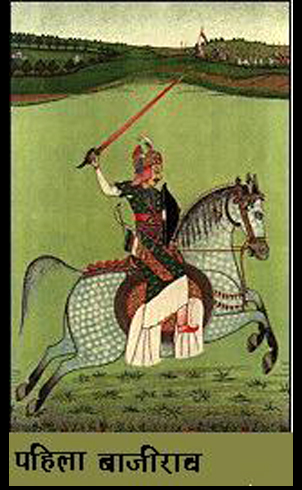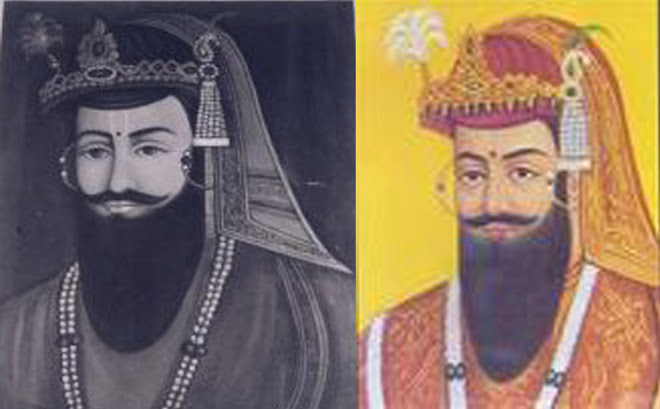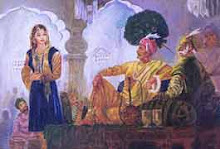Shaniwar Wada (Marathi: शनिवार वाडा) is a palace fort in the heart of Pune City, India. It was the seat of Peshwa rulers until 1818 when the Peshwas surrendered to British. In 1828 AD, an unexplained fire gutted the buildings in this palace complex. All that remains now are their stone plinths and the perimeter fortification wall.
The walls of the shaniwarwada fort
Shaniwar is Marathi for Saturday. A [wada] is Marathi for a group of houses together in a complex, not necessarily royal, though this one was. The Shaniwar Wada palace complex contained the magnificent and stately mansions built by the Peshwas, for their residences.
For more Details http://en.wikipedia.org/wiki/Shaniwar_Wada
Time Line of Peshwe
Balaji Vishwanath : 17.11.1713 to 2.4.1720 ( death)
Bajirao (I) : 17.4.1720 to 28.4.1740 (death)
Balaji Bajirao aka Nanasaheb : 25.6.1740 to 23.6.1761 (death)( he was removed as Peshawa during the period Mar-1744 to 13.4.1744 and then reappointed )
Madhavrao : 20.7.1761 to 18.11.1772 (death)
Narayanrao : 13.12.1772 to 30.8.1773 ( murder )
Raghunathrao : 10.10.1773 upto 8 months ( removed )Gangabai ( wife of Narayanrao) : 18.1.1774 to 27.5.1774 ( on behalf of Barbhai)
Sawai Madhavrao : 28.5.1794 to 27.10.1795 (death)
Chimnaji ( adopted ) : 26.5.1796 to 27.10.1796
Bajirao ( II) : March - 1796 to May 17964.12.1796 to 24.10.180213.3.1803 to 3.6.1818 ( end of Peshwai )
Bajirao (I) : 17.4.1720 to 28.4.1740 (death)
Balaji Bajirao aka Nanasaheb : 25.6.1740 to 23.6.1761 (death)( he was removed as Peshawa during the period Mar-1744 to 13.4.1744 and then reappointed )
Madhavrao : 20.7.1761 to 18.11.1772 (death)
Narayanrao : 13.12.1772 to 30.8.1773 ( murder )
Raghunathrao : 10.10.1773 upto 8 months ( removed )Gangabai ( wife of Narayanrao) : 18.1.1774 to 27.5.1774 ( on behalf of Barbhai)
Sawai Madhavrao : 28.5.1794 to 27.10.1795 (death)
Chimnaji ( adopted ) : 26.5.1796 to 27.10.1796
Bajirao ( II) : March - 1796 to May 17964.12.1796 to 24.10.180213.3.1803 to 3.6.1818 ( end of Peshwai )
Friday, February 1, 2008
Vishrambaug Wada
The Vishram-baug wada is a historic Peshwa mansion, built in 1811 by Peshwa Baji Rao the second, for his relaxation and entertainment. This Wada has a large dancing hall, which still houses a large number of artifacts: paintings, chandeliers, vases and other knick-knacks belonging to the Peshwas.
For more details http://ramrao1.tripod.com/vbwada.html
For more details http://ramrao1.tripod.com/vbwada.html
Bajirao - Mastani
In 1739 the Bajirao - Mastani affair had brought clashes among the Peshwa family, hence Bajirao Peshwa took Mastani away from Pune and made her stay in Patas. Hence forth Bajirao and Mastani met at the Firangai Devi temple in Kurkumb.
Saturday, January 19, 2008
The Peshwa
The Peshwa(Marathi:पेशवे or पेशवा) (also known in Marathi as Peshwe) were Brahmin Prime Ministers to the Maratha Chattrapatis (Kings), who began commanding Maratha armies and later became the hereditary rulers of the Maratha empire of central India from 1749 to 1818. Prior to 1700 AD,One Peshwa also got king status for 8-9 years. They oversaw the greatest expansion of the Maratha Empire around 1760 with the help of Sardars (Generals)like Hokar,Shinde, Bhosale,Pantprainidhi, Gayakwad, Pethe, Raste, Phadke, Patwardhan, Pawar, Pandit and Purandare, and also its eventual annexation by the British East India Company in 1818.
Subscribe to:
Posts (Atom)

Peshwa Balaji Vishwanath
Balaji Vishwanath Bhat (1680 – April 2, 1719), better known as Peshwa Balaji Vishwanath, was the first of a series of hereditary Peshwas (Marathi for Prime Minister) hailing from the Bhatt family who gained effective control of the Maratha Empire during the eighteenth century. Balaji Vishwanath assisted a young Shahu to consolidate his grip on an empire that had been racked by civil war and persistent attack by the Mughals under Aurangzeb.
Bajirao I

Baji Rao I
Shrimant Baji Rao Balaji Bhat (August 18, 1699- April 25, 1740), also known as Baji Rao I, was a noted general who served as Peshwa (Prime Minister) to the fourth Maratha Chhatrapati (Emperor) Shahu between 1719 until Baji Rao's death. He is also known as Thorala (Marathi for Elder) Baji Rao.
Despite being a Brahmin, he took up leading his troops. He is credited with expanding the Maratha Empire created by its founder, Shivaji, to help reach its zenith during his son's reign twenty years after his death. Baji Rao is thus acknowledged as the most famous of the nine Peshwas.
Despite being a Brahmin, he took up leading his troops. He is credited with expanding the Maratha Empire created by its founder, Shivaji, to help reach its zenith during his son's reign twenty years after his death. Baji Rao is thus acknowledged as the most famous of the nine Peshwas.
Nanasaheb Peshwa (Balaji Bajirao)

Nanasaheb Peshwa (Balaji Bajirao)
Nanasaheb Peshwa also known as Balaji Bajirao, (born 1720 or 1721 - Died 1761) was one of the Peshwas of the Maratha Empire. He contributed heavily to the development of the city of Pune, India. He was appointed as Peshwa by Chattrapati Shahu himself. At time of his death in 1749, the issueless Shahu made the Peshwas the rulers of the Maratha
Madhavrao Peshwe

Madhavrao Peshwa
Madhavrao I
Madhavrao Peshwa (1745 – 1772) was the second son of Nanasaheb Peshwa. He ruled Pune, India from (1761 - 1772). He became ill (possibly due to tuberculosis) in 1771 and died in 1772 at an early age of 27. He was succeeded by his younger brother Narayanrao Peshwa.
Madhavrao II (1774-1795) was peshwa of the Maratha kingdom in India, from a young age. He was the posthumous son of Narayanrao Peshwa, murdered in 1773 on the orders of Raghunathrao.[1] Madhavrao was considered the legal heir, and was brought to power as peshwa by the treaty of Salbai in 1782.
His time in power was dominated by the political intrigues of Nana Phadnis. Madhavrao's death was said to be by suicide.
Madhavrao Peshwa (1745 – 1772) was the second son of Nanasaheb Peshwa. He ruled Pune, India from (1761 - 1772). He became ill (possibly due to tuberculosis) in 1771 and died in 1772 at an early age of 27. He was succeeded by his younger brother Narayanrao Peshwa.
Madhavrao II (1774-1795) was peshwa of the Maratha kingdom in India, from a young age. He was the posthumous son of Narayanrao Peshwa, murdered in 1773 on the orders of Raghunathrao.[1] Madhavrao was considered the legal heir, and was brought to power as peshwa by the treaty of Salbai in 1782.
His time in power was dominated by the political intrigues of Nana Phadnis. Madhavrao's death was said to be by suicide.

Imaginary Picture of Mastani
Mastani
Mastani was a daughter of a Hindu, Maharana Chhatrasal (1649-1731), of Bundelkhand province, and was borne by his Persian Moslem wife. When a Mughal chief from Allahabad, Mohammad Khan Bangash, invaded Chhattrasal’s kingdom during 1727-28 and imprisoned him and his family, Chhattrasal sent a secret message, seeking help, to Baji Rao, who happened to be on a military campaign in the vicinity of Bundelkhand. Bajirao came to the rescue of Chhatrasal, defeated Bangash's army, and restored Chhatrasal to his throne. In gratitude, Chattrasal gave Bajirao his daughter Mastani, and also a third of his kingdom, including Jhansi, Sagar and Kalpi.Mastani was a skilled horse-rider, and she accompanied Baji Rao on his military campaigns. According to legends, she was skilled in spear-throwing and swordsmanship. She was also a talented dancer and singer. Both Masatani and Baji Rao's wife, Kashibai, bore sons to Baji Rao within a few months of each other. Kashibai's child died at an early age. Mastani's child was named Shamsher Bahadur.However, Baji Rao's love for his half-Moslem mistress Mastani, and neglect of Kashibai angered his mother, Radhabai. In deference to Radhabai, Baji Rao's brother, Chimnaji Appa, tried to send Mastani into exile. Baji Rao's son, Balaji, also tried to coerce Mastani into leaving his father, but she refused. Enraged by her growing influence on Baji Rao, and Baji Rao's neglect of Kashibai, Balaji had Mastani placed under house arrest for a time, while Baji Rao was on military campaign.Mastani lived for some time with Baji Rao at his palace of Shaniwar Wada in the city of Pune. The palace's north-east corner held Mastani Mahal and had its own external doorway called Mastani darwaza. Because of his family's intolerance of Mastani, Baji Rao later built a separate residence for Mastani at Kothrud, some distance away from Shaniwar Wada. Court records (Bakhars) during Bajirao's regime specifically never included any reference to her.Historians have determined that the paintings of Mastani in both Raja Kelkar museum and Wai museum are not authentic.
Thorale Bajirao Peshwe










